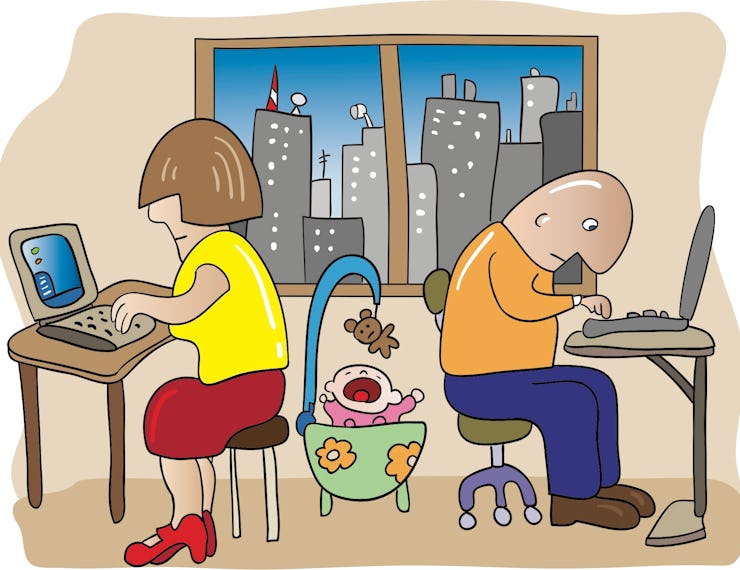6 tips to actually get work done at home, from the parenting experts
If you’ve been struggling with your dual role of working and parenting, here are six tips from professionals with experience doing both.
by Stephen J. BronnerWorking from home can be a tough transition, but for those of us with children, the challenge is exponentially tougher. Not only do parents have to do their jobs, but they also have to fill in as teachers or childcare workers. Also, many younger kids likely don't understand why mommy and daddy are home but unavailable all the time to play or read books to them.
If you’ve been struggling with your dual role of working and parenting, here are six tips from professionals with experience doing both.
6. Plan, plan, plan
“Plan out your week on Sunday and then plan out each day the night before. It takes 15 to 20 minutes for the weekly plan and 10 to 15 minutes for the daily plan,” said author and speaker Suzanne Brown.
“You'll know your goals and priorities and how you can reprioritize. If you have a significant other, do this plan together and think through how you can work as a team. This can give you an idea of who has meetings when and who can do kid duty as necessary throughout the day. Prep lunches in the morning. Plan your clothing and that of your child the night before. Have diapers easily available. You want your day to be focused on your work and your child, not trying to figure out all the other things.”
5. Schedule your day
"The secret is to assign some time slots and home areas to work and some others to child care. This way, when one parent is working, they can focus on work, while the other parent is taking care of the children,” said Thibaud Clement, CEO and co-founder of Loomly.
“Conversely, when one parent is taking care of the kids, they can dedicate their full mind to the kids, as they know they will have some time later on to focus on work. Alternating and spreading out these times throughout the day in a balanced manner allows each parent to have enough time to satisfy their respective work obligations while also taking care of their little ones. This tends to stretch the days a bit, but it’s much more efficient and sustainable than multitasking. (If you have ever tried to type an email while watching a 1-year-old, you know what I mean.)”
4. Set your kids’ routine
“When they’re in school, your kids know exactly what to expect. They understand where they’ll be and what they’ll be doing at a given time,” said Jess Ullrich, editor at FinanceBuzz.
“Many kids feel comfortable and secure when they follow a set routine, so try creating one at home. Figuring out one that works for your family might take some time, so be patient with the process. If your kids have a remote curriculum in place from their school, set aside a block of time in the morning for schoolwork. If they don’t, use that time for educational activities like buddy reading, drawing a picture, or writing a letter to a friend. Make yourself available to them if they need help, but set the expectation that you’ll be working during this time. Also, designate time for fun activities, simple chores that they can do independently, and time outside."
3. Set boundaries
"The key to getting work done at home when you have kids is boundaries,” said Jason Lee, CEO of Freelance Master Course, a company that specializes in training at-home workers.
“First, set the expectations clearly. This means have an actual direct conversation with exactly what you expect. You can't count on your kids or your spouse to support your needs when you haven't made those needs crystal clear. Second, set times when you will take breaks and can be accessible. If your kids know that mom or dad isn't available now but will be at every, say, even hour (10 a.m., noon, 2 p.m., etc.), they tend to be a bit more patient. If they think they can't talk to you for eight hours straight, good luck enforcing those boundaries.”
2. Lean on your village
“Schedule calls with family members and loved ones who can teach your kids things,” said Lori Mihalich-Levin, author and founder of Mindful Return.
“Every day at 4 p.m., we have a different family member FaceTime or Zoom with our kids (each family member gets the same day each week for predictability!), and we ask them to teach the kids something when they're together.”
1. Create creative distractions
“What works for me is setting up themed activity baskets of toys, games, activities, and books that children enjoy and switching out baskets as children lose interest,” said Varda Meyers Epstein, parenting writer at Kars4Kids.
“You can probably manage to make baskets with items you already have on hand. You can use a food storage container as a ‘basket’ and look for ways to group items that suggest a theme. An example might be a ‘playing doctor’ basket. In that container or basket, you’d put a toy stethoscope and thermometer, a white jacket, a doll to serve as a patient, and perhaps a book about visiting the doctor.”
